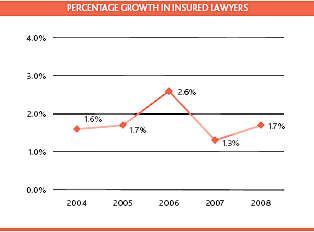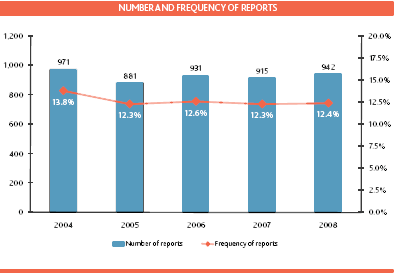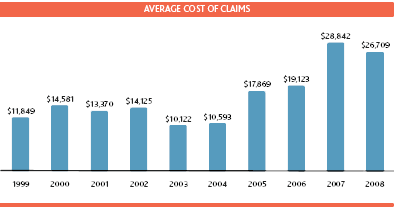The Lawyers Insurance Fund manages the Law Society’s insurance program for BC lawyers. The program provides insurance for negligence (Part A of the policy) and theft (Part B of the policy).
In managing the program, we are guided by our mission statement, which is:
The Lawyers Insurance Fund protects the profession and the public from the risks associated with the practice of law by providing high quality professional liability and defalcation insurance. We draw on our knowledge and skill as experienced lawyers to deliver professional and cost-effective claims and risk management, and underwriting services. Through hard work and best practices, we ensure the continuing excellence of the insurance program and maintain the confidence of the profession.
Assessment
For the third consecutive year, the Benchers have set the annual assessment for Part A professional liability insurance at $1,400. Nearly two decades ago, the assessment was $2,600, the highest in the program’s history. The current assessment maintains the historic low set in 2007, realized as a result of the Fund surplus, stable loss experience and effective claims management by the Lawyers Insurance Fund. However, an anticipated increase in the cost of claims due to the economic downturn is likely to lead to an increased assessment in 2010.
No fee will be charged or assessment levied for Part B trust protection coverage in 2009.
Compulsory policy wording
A consolidated policy for 2009 was issued. There are no material changes to coverage, although some revisions are made to help clarify the policy’s intent. In addition, changes to the wording made by endorsements in 2008 are incorporated, and numerous small editing revisions required for consistency in language and punctuation are made. The following highlights the more significant of the clarification revisions (please see the enclosed policy for the exact wording of the provisions referenced below):
Part A (insurance for negligence)
$1 million limit
The policy’s $1 million limit of liability has always applied to claims that arise from either:
- a single error; or
- more than one error if the errors are related (related errors are deemed to be one error).
The definition of “error” now more clearly specifies the circumstances in which errors or mistakes are related. Mistakes are related when they are logically or causally connected or cause a single loss to one or more claimants. Mistakes are also related when they occur in relation to the same set of underlying facts, events, transactions, activities or undertakings. Examples of “underlying” matters are provided: accidents, investment programs or schemes, offerings of ownership interest or debt, corporate reorganizations, tax plans, estates, real estate developments, commercial ventures and litigation matters. Finally, mistakes are related if they occur in the course of a lawyer acting as an administrator, executor, guardian, trustee or committee (lawyers acting in such capacities generally enjoy coverage under the policy).
Mistakes are not related, however, simply because they are identical or cause losses to the same client. For example, repeating the same drafting error in every will prepared for different clients, or making mistakes in both a motor vehicle claim and a conveyance for the same client, will not, without more, make the mistakes related.
In addition, Condition 1.3 provides that if one or more claims result from an error (includes related errors, if there is more than one mistake), those claims are subject to the $1 million limit of liability. Once that limit applies, it applies regardless of the number of claims or claimants or firm lawyers involved, or the number of different capacities in which the lawyer acts.
Professional services
Sometimes, lawyers are approached by rogues who want to use the lawyer’s trust account as a conduit for funds — for instance, to promote a fraudulent investment scheme. There is no coverage for any claim that might arise, as no actual legal services are being provided. The definition of “professional services” now specifically provides that a lawyer who is merely acting as a conduit for funds is not providing professional services. This amendment also reinforces the exclusion of investment advice or services, noted below.
Exclusions
As the risks of offering investment advice or services are not risks to which the policy is intended to respond, Exclusion 10 is added to exclude coverage for investment advice or services unless as a direct consequence of the lawyer providing legal services. As investment services may include allowing investment funds to flow through a trust account, the revision to the definition of “professional services” noted above helps clarify coverage in this regard.
Exclusion 11 is added to clarify that Part A of the policy does not extend coverage to claims arising out of thefts by law firm employees.
Conditions
Condition 9 provides that the compulsory policy is excess over any other insurance (other than excess insurance) or right of indemnity. A further addition confirms that the policy will respond after such recourse is exhausted.
The policy’s limits are unchanged: each insured lawyer enjoys $1 million of coverage for all claims arising out of a single error or a series of related errors, to an annual maximum of $2 million for all claims arising out of separate errors reported during the year. Both limits are eroded by defence costs. The deductible remains at $5,000 for a paid claim, increasing to $10,000 for each subsequent paid claim reported within three years. As always, lawyers will want to consider if excess insurance is appropriate for their needs (see below).
Part B (insurance for theft)
Exclusion 17 of the policy (formerly Exclusion 15), excludes coverage under Part B for claims arising from or in connection with investments. The exclusion is revised to clarify that Part B does not apply in any circumstances to losses resulting from fraudulent investment schemes.
The policy continues to provide a profession-wide aggregate limit of $17.5 million for Law Society members, and a per claim limit of $300,000. Although there is no deductible, lawyers are obliged to reimburse the insurer in full for paid claims.
A copy of the 2009 consolidated policy is enclosed in this mailing. Copies of other policies and endorsements issued since 1999 are available in the Lawyers Insurance Fund’s section of the Law Society’s website.
A review of claim and potential claim reports
Part A (insurance for negligence)
The program remains stable, as illustrated by the charts on pages 2 to 4. 2008 saw little change in either the number of insured lawyers or the number of reports. Although there has been an upward trend in the average cost of claims over the past four years, changes over the past 10 years remain gradual. Although the average cost of claims is based on actuarial estimates that tend to decrease as time passes, future losses may be greater as a result of the dramatic shift in economic conditions.
The chart Percentage growth in insured lawyers shows the percentage growth over the past five years. Insured lawyers include both full and part-time lawyers and reports include both claims and potential claims.

The chart Number and frequency of reports shows the number of reports and the frequency of reports (reports divided by insured lawyers) over the past five years.

The chart Average cost of claims shows the average cost per report over the last 10 years, based on the actuary’s estimate of expected losses.

Part B (insurance for theft)
Since Part B, or trust protection coverage, was introduced in May 2004, there have been 95 reports of claims and potential claims involving 44 lawyers. However, in many of these reports the claim is without merit, and our claims experience continues to reflect that of the Law Society’s historically: only a very small number of lawyers are involved in misappropriations.
In 2008, eight claims were paid on behalf of six different lawyers, totalling approximately $24,000. This compares with seven paid claims in 2007 totalling approximately $39,000 and three paid claims in 2006 totalling approximately $6,300. No claims were paid in 2004 or 2005. Details of the claims paid in 2008 follow:
- A payment of $2,501 was made on behalf of a lawyer who was retained to proceed with a sponsorship application in an immigration matter. The lawyer paid himself the retainer funds although no account was rendered nor work done to justify a fee. Before 2008, five claims totalling $10,754 were paid on behalf of that same lawyer.
- A payment of $500 was made on behalf of a lawyer who was retained to pursue a claim arising from a client’s investment in a business venture. The lawyer kept the retainer funds but provided no services to the client. A claim in the amount of $515 was paid earlier on behalf of that same lawyer.
- Two claims totalling $1,483 were paid on behalf of a lawyer. In the first, the lawyer received funds to pay disbursements pursuant to a contingency fee agreement. The lawyer kept the funds. In the second, the lawyer submitted an application to the Land Title Office to transfer estate property. The application was rejected and the documents returned to the lawyer, together with funds provided by the client to pay Property Transfer Tax. The lawyer kept the funds. A claim in the amount of $26,718 was paid earlier on behalf of that same lawyer.
- A payment totalling $2,386 was made on behalf of a lawyer who was retained to pursue a civil litigation matter. Although the client’s claim was dismissed for want of prosecution, the lawyer continued to render accounts and receive payments for services purportedly provided.
- Two claims totalling $16,606 were paid on behalf of a lawyer. In the first, the lawyer acted for a mortgagor to pay out an existing mortgage and borrow additional funds. The lawyer misappropriated a portion of the additional funds. In the second, the lawyer acted for an executor and misappropriated estate funds.
- A payment of $227 was made on behalf of a lawyer retained to pursue a civil litigation matter. The lawyer paid himself the retainer funds although no account was rendered. Some work was done but it was not enough to justify taking the full amount of the retainer.
None of the lawyers involved remain as members of the Law Society, and all are obliged to reimburse the Law Society for the amounts paid on their behalf. Five claims were withdrawn or abandoned by claimants, and five matters reported as potential claims did not develop into claims. One claim was resolved as funds paid to a third party were repaid. One claim did not fall within coverage for Part B, and no payment was made. In this claim, there was no evidence that money paid to an immigration consultant was ever received or taken by the lawyer. In the remaining reports, the claimants are not actively pursuing a Part B claim, or we are not yet in a position to determine if the claim is properly payable or, in some instances, to whom. On some matters we must wait until the conclusion of the discipline process to complete our assessment of the claim. In others, although the potential claim likely falls outside of coverage, we are not able to finalize this position until a claim is advanced.
For a full description of Part B trust protection coverage, including claims management and coverage, please see Insurance Issues No. 2 May – June 2004. Frequently asked questions designed specifically for the public are available on the Lawyers Insurance Funds’ section of the Law Society’s website (lawsociety.bc.ca).
Excess insurance — Do you have protection for claims over $1 million?
As noted above, all claims arising out of either a single error or related errors are subject to the $1 million limit of coverage, and claims arising out of separate errors are subject to the $2 million annual aggregate. These primary limits are reduced by indemnity (settlements or judgments) and defence costs paid.
Although the $1 million limit offers generous financial protection for the majority of claims faced by lawyers, the limit, as well as the scope of coverage, may not be enough to protect you from the potential liability risks inherent in your practice. Personal liability for defence costs and damages that are ultimately uninsured can be financially devastating. Assess your own exposure to claims that exceed the primary limits or fall outside coverage. For example, what is the potential financial fall-out from your biggest file — the client with the most to gain, or lose, as a result of your services? The adequacy of insurance depends, in part, on the nature of a lawyer’s own activities, as well as those of partners, associates and employees and the potential impact of those activities, in a worst case scenario, on clients and third parties who may allege a duty owed.
Excess insurance extends the primary limits and may pick up risks not covered by our policy. We strongly recommend that all lawyers consider both the financial and “sleep-easy” benefits excess insurance offers. It is available on the private market. Consult a broker experienced in lawyers’ liability insurance to help assess your own needs, and determine if excess insurance is appropriate for your firm. Buy it if you may be at risk.
Lawyers Insurance Fund: Service first
Insured lawyers continue to give the Lawyers Insurance Fund high ratings for service in Service Evaluation and Risk Management Forms sent on file closing. The lawyer is asked to rate his or her satisfaction on a scale of 1 (“not at all”) to 5 (“a lot”) in a number of areas relating to our performance. We also specifically ask for comments, both positive (“kudos”) and negative (“grumbles”) regarding the services provided. These comments provide valuable information that assist the Lawyers Insurance Fund in planning improvements in service. Whenever an insured lawyer has a negative comment, we follow up to address the concern.
Our insureds continue to express high satisfaction overall with the services we provide, as indicated by these examples from the hundreds of kudos we received in 2008:
- Claims counsel provided excellent assistance which equals service in every case. He was well informed, provided insightful advice and demonstrated that he cared about me and the outcome.
- Claims counsel was exceptionally supportive throughout the process and provided me with guidance that gave me much needed peace of mind. She was never harsh or judgmental, and made a difficult situation manageable.
- Claims counsel provided practical, effective and immediate advice. We followed her directions and avoided a claim altogether. Couldn’t have done better.
In addition, 94% of survey respondents gave a high approval rating (4 or 5 on a scale of 1 to 5) on the services provided by defence counsel and on the outcome of their claims, 95% on the handling of their claims, and 97% on the services provided by LIF Claims Counsel.
2009 and beyond
We have entered an economic recession, and the program’s costs are expected to increase as a result. However, even these challenging times will not undermine the stability of the program as the Lawyers Insurance Fund continues to effectively manage claims in accordance with its stated mission. Further, the extent of any increased costs will be limited if lawyers embrace risk management. Read risk management material such as Hard Times: Managing risk in a troubled economy and Beat the clock: Timely lessons from 1,600 lawyers (all available at lawsociety.bc.ca). Act on the recommendations. Participate in post-call legal educational activities to remain current in the law while discovering practical tips and strategies for practising defensively. Managing risk effectively and buying excess insurance if you are at risk will help you, and your colleagues, “sleep easy” in 2009.